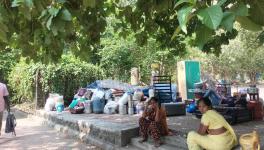Residents of Mumbai’s ‘Critically Polluted Area’ Demand ‘Right To Life’

Facing continuous negligence and lack of empathy by the Maharashtra government to rising pollution and its consequent impact on their health, residents of Mahul in Mumbai have been protesting in huge numbers since October 28, demanding their rehabilitation in a cleaner living environment.
On Tuesday, as the agitation, called the Jeevan Bachao Andolan, entered its third day on Tuesday, around 500 people gathered at the Tilak Nagar Police station in Mumbai, where some of the residents have been detained.
The problems of the residents of Mahul began in 2009, when the Bombay High Court (HC) ordered the BMC (Brihanmumbai Municipal Corporation) to remove encroachments near the Tansa pipeline that runs across nine administrative wards of the city. In 2017, around 5,000 families, mostly from poor backgrounds and marginalised communities, were rehabilitated to Mahul. But reports from the National Green Tribunal, various NGOs as well as surveys by the KEM Hospital, have proved that Mahul being close to oil refineries of BPCL (Bharat Petroleum Corporation Limited) and other companies, and carcinogenic chemical storage tanks, is critically polluted (also backed by the Central Pollution Control Board) and an inhabitable place with potential risk to lives.
This high level of pollution has been blamed for causing cancer and various health problems, like breathlessness, asthma, tuberculosis, eye irritation, skin diseases and repeated choking sensation resulting in death of more than 100 residents in the past two years. The area also lacks basic amenities, such as schools, hospitals and medical shops.
Government Ignored HC Order on Rehabilitation
The Bombay HC on June 15, 2018, ordered the Maharashtra government to rehabilitate the residents of Mahul to a better area in Mumbai and if the government was unable to do so, asked it to pay the displaced people monetary compensation to enable them to rent houses in better places in Mumbai.
The Maharashtra government was asked to bring about positive solutions for the Mahul residents before October 1, 2018, but it has chosen to turn a blind eye to plight of people dumped in the deadly areas of Mahul.
The residents, numbering around 300 initially, having lost patience and hopes, are terrified after the August 8 BPCL blast, which triggered a protest demonstration on October 28 seeking answers from the Fadnavis government.
On October 29, on the second day of the protest, the police picked up more than 100 people who were protesting peacefully and took them to the Tilak Nagar police station, and pressured them to stop protesting and go back to Mahul. The determined residents continued to protest inside the police station.
“As more people in support started pouring into the police station, the police was compelled to release the residents and the protesters were allowed to continue with their sit-in”, said Bilal Khan, a member of the Ghar Bachao Ghar Banao Andolan (Save Home Build Home movement), which is also participating in the protest. Members of the Aam Aadmi Party also showed up at the protest site in solidarity.
As of now, the situation is tense but there has been no response from the Maharashtra government. Meanwhile, more and more police continues to be deployed around the protest site, as the number of protesters is swelling, with students from Tata Institute of Social Sciences, Mumbai, and several other organisations lending their support.
With no signs of any response so far from either Chief Minister Fadnavis or the BMC, the residents seem determined to intensify their struggle after years of living in a toxic environment. They said they would continue with the protest till the government announces concrete action with regard to their demands.
(Bidisha Barman is a freelancer based in Pune)
Get the latest reports & analysis with people's perspective on Protests, movements & deep analytical videos, discussions of the current affairs in your Telegram app. Subscribe to NewsClick's Telegram channel & get Real-Time updates on stories, as they get published on our website.
























